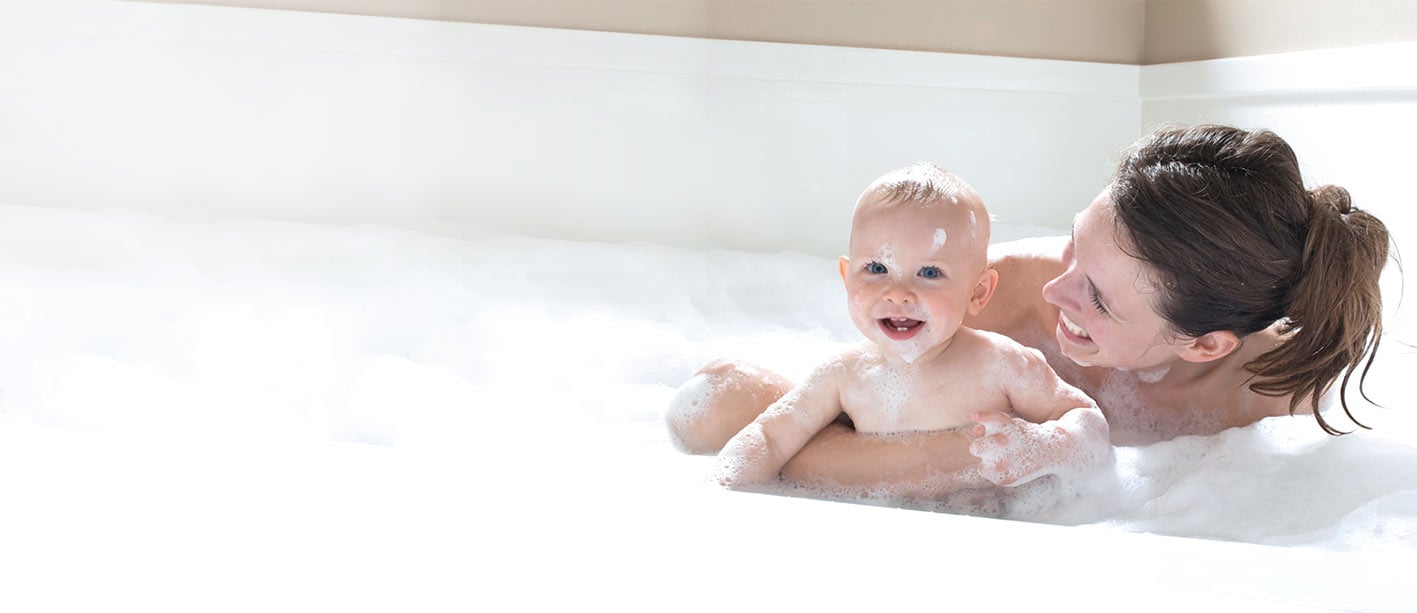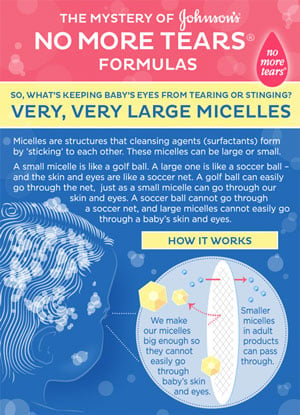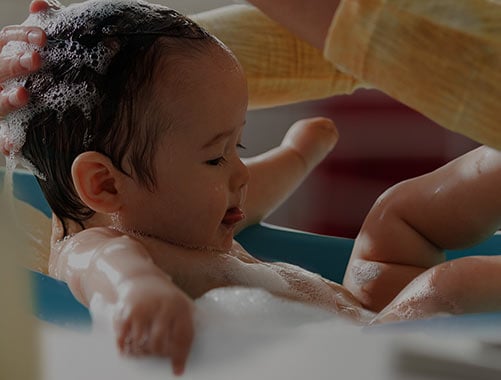The Simple Truth
To help mums and dads understand the simple truth about our products, we’ll show you what’s behind the label, dispel common myths and answer popular questions about our ingredients. The safety of your little one is your number one priority, so of course you want to know what’s best for your baby.

Your top questions answered
Is Johnson’s safe for my baby?
Learn about the Johnson’s 5 step safety process
How can I understand ingredient labels?
Learn about the INCI labelling system
What does 'Natural' & ‘Chemical’ mean?
Learn about terms like natural & chemical
Formaldehyde and added parabens
Learn the truth about our ingredients
Is talc safe to use on my baby?
Learn more about talc
Do Johnson's products contain mineral oils?
Learn more about mineral oils
Are fragrances in baby products an issue?
Learn more about fragrances
Product Safety
Knowing what’s in a product is important, and we take it seriously. We follow strict rules and guidelines when it comes to labelling our products so you can know what they contain. We want both you and baby to rest easy.
For us, the health and safety of your family always comes first. Our products have been tested for decades to ensure they’re safe and gentle for baby’s delicate skin. You might not have known it, but we consult with doctors and scientific experts who make sure every ingredient we use is proven safe for babies1. We’re always listening to feedback from mums and dads like you, and monitoring the latest scientific data to make sure our products are as mild and gentle as can be. You can take a closer look at our five-level safety assurance process by visiting our website, www.safetyandcarecommitment.com. Or watch our Q&A video
1JOHNSON'S. "Johnson's Safety Standards." JOHNSON'S®. October 27, 2015. Accessed April 10, 2016. http://www.johnsonsbaby.com/johnsons-baby-skin-care/johnsons-safety-standards
A baby's skin is much more delicate than ours, and needs extra special care. This is why we make sure that every single JOHNSON'S® baby product is clinically proven mild, and that it can carry this unique stamp.
To earn this stamp, every formula must pass through two strict clinical tests, carried out to minimise
irritation
an allergic reaction
We spend months rigorously testing and, only after a product has passed every test, will we allow it to be used on your little one's beautiful skin.
Because babies have delayed blink and tear reflexes, they’re less able to protect their eyes and rinse out harsh substances. That’s why we created our NO MORE TEARS® range.
To earn our NO MORE TEARS® stamp, each product must pass through two strict stages of testing:
Ingredient & formulation review
Pre-clinical safety evaluation
We do this to make sure it's mild on your baby's sensitive eyes, and only then do we give it the special stamp that's been trusted by generations of mums.
Ingredient Safety FAQ’s
Our ingredient lists seem a bit long and confusing, don’t they? That’s because we’re committed to following the International Nomenclature of Cosmetic Ingredients Guidelines (INCI) for labelling. So some simple ingredients sound more complicated than they are, for example, “Aloe Barbadensis Leaf Extract” is simply the INCI label name for ‘aloe vera leaf extract.
For a better understanding of each ingredient, visit our Ingredient Glossary.
Our products are non-toxic, and none of them contain ingredients classified as carcinogens. In fact, we have very strict safety testing standards, and are constantly researching and updating our products to respond to new research.
We absolutely do not use any numbing agents, and would never include anything that could harm a baby.The reason we can make the claim ‘NO MORE TEARS®’ is simple. Read the infographic below to find out why.

Every ingredient fulfills a specific purpose, carefully selected to be best for your baby. Below you’ll find a breakdown of label ingredients so you can better understand the ingredient names that are written to INCI guidelines. For example, “Aloe Barbadensis Leaf Extract” is simply the INCI label name for ‘aloe vera leaf extract’.
JOHNSON'S® baby TOP-TO-TOE® wash
Mild cleanser
Cocamidopropyl betaine
PEG-80 sorbitan laurate
Sodium trideceth sulfate
Helps keep the product fresh
Tetrasodium EDTA
Sodium benzoate
Ethylhexylglycerin
Phenoxyethanol
Helps maintain product thickness
PEG-150 distearate
Moisturisation
Glycerin
Polyquaternium-10
Helps adjust pH balance
Citric acid
Sodium hydroxide
Provides a light scent
Fragrance
JOHNSON'S® baby shampoo
Mild cleanser
PEG-80 sorbitan laurate
Coco Glucoside
Sodium Lauroamphoacetate
Sodium Laureth Sulfate
Helps keep shampoo Fresh
Sodium benzoate
Helps maintain shampoo thickness
PEG-150 distearate
Polysorbate 20
Moisturisation
Glycerin
Polyquaternium-10
Helps adjust pH levels
Citric acid
Provides a light scent
Fragrance
Mild coloring
Yellow 6
Yellow 10
JOHNSON'S® baby lotion
Helps lotion blend
Stearic Acid
Glyceryl Stearate
Cetyl Alcohol
Cetearyl Alcohol Polysorbate 20
Helps keep the lotion fresh
Phenoxyethanol
P-Anisic Acid
Ethylhexylglycerin
Pentaerythrityl Tetra-di-t-butyl Hydroxyhydrocinnamate
Helps maintain lotion thickness
Magnesium Aluminum Silicate
Carbomer
Xanthan Gum
Moisturisation
Isopropyl Palmitate
Glycerin
Dimethicone
Mineral Oil
Helps adjust pH levels
Sodium hydroxide
Provides a light scent
Fragrance
Mild colouring
CI 17200
We know mums and dads are interested in our ingredients, and we can assure you were always working to keep up our high standards. Here’s a rundown of how we’ve changed our use of particular ingredients in our new formulations.
Ingredient FAQs:
Is there formaldehyde in any of your baby products?
We never add formaldehyde directly into our products. In the past, we had formaldehyde-releasing preservatives, which release tiny amounts of methylene glycol, alcohol form of formaldehyde, at the level considered safe by regulators.
However, we heard your worries and we want you to have peace of mind. All our baby products have been reformulated and they no longer contain formaldehyde-releaser.
You can learn more at www.safetyandcarecommitment.com
Does Johnson’s Baby range in Australia contain parabens?
We know you were worried about parabens, and while they are very useful and safe at less than 1% in personal care products according to The Expert Panel of the U.S. Cosmetic Ingredient Review, the comfort and care of you and your family was not up for debate. So, we have phased out the use of parabens from all our baby products.
Do you use phthalates in any of your baby products?
To give you peace of mind, all our baby products worldwide are now phthalate-free, and will remain so. We stopped using Diethylphthalate (DEP), a low-weight phthalate that was considered to have a well-established fragrance profile by scientific experts in all our adult products in 2015.
Why is colouring used?
Colours are sometimes used to help you distinguish between products to prevent mix-ups, and to make our products look a little nicer. The amounts we use are minimal, can be as low as 0.0002%, and gentle enough to use on baby’s delicate skin.
Do you use MIT in any of your baby products?
No. A preservative found in many consumer and household products, Methylisothiazolinone (MIT) is not contained in our JOHNSON’S®Baby range in Australia.
Do you use Quaternium-15 in your baby products?
No. Even though the amount of formaldehyde found in one healthy apple is equal to the amount found in 10 bottles of our product, we no longer use the formaldehyde-releasing preservatives Quaternium-15 in our baby products globally.
Do you use SLS in any of your baby products?
No. Sodium lauryl sulphate (SLS) allows liquid to foam, and although it has an excellent 70-year safety record, SLS is not an ingredient in JOHNSON’S® Baby products in Australia. Instead we use Sodium Laureth Sulfate (SLES) which helps provide a better balance of foam and mildness.
Natural Ingredient FAQ
Vegetable oils contain unsaturated fatty acids, which can go rancid, while mineral oils do not. Specifically developed for baby’s delicate skin, when our highly-refined mineral oil is used as a moisturiser, it’s proven to relieve dryness and keep skin soft.
Of course, the quality and safety requirements used for selection of mineral oils are of the highest standard.
Although we think that using natural and naturally derived ingredients is important, there are times when synthetic ingredients are a better alternative for baby. After all, not all natural ingredients are safe. Some can be affected by unpredictable changes in quality, others are subject to contamination, and some of the strongest known allergenic substances come from plants. Natural and naturally derived ingredients are used in our products, but only if they meet our strict quality standards.
Animal Testing
JOHNSON'S® baby products sold in Australia/New Zealand are not tested on animals. In fact, no companies in the Johnson & Johnson Family of Companies conduct testing of personal care and cosmetic products on animals.
Globally, we follow the EU animal testing ban and do not test cosmetic ingredients on animals, except for cases where testing is required by law or government authorities.
As a company, we're committed to both supporting work to eliminate the use of animal testing, and developing alternative, non-animal research methods.
